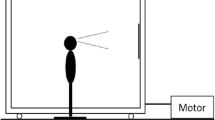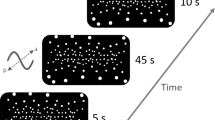Abstract
The postural instability theory of motion sickness predicts that subjective symptoms of motion sickness will be preceded by unstable control of posture. In previous studies, this prediction has been confirmed with measures of the spatial magnitude and the temporal dynamics of postural activity. In the present study, we examine whether precursors of visually induced motion sickness might exist in postural time-to-contact, a measure of postural activity that is related to the risk of falling. Standing participants were exposed to oscillating visual motion stimuli in a standard laboratory protocol. Both before and during exposure to visual motion stimuli, we monitored the kinematics of the body’s center of pressure. We predicted that postural activity would differ between participants who reported motion sickness and those who did not, and that these differences would exist before participants experienced subjective symptoms of motion sickness. During exposure to visual motion stimuli, the multifractality of sway differed between the Well and Sick groups. Postural time-to-contact differed between the Well and Sick groups during exposure to visual motion stimuli, but also before exposure to any motion stimuli. The results provide a qualitatively new type of support for the postural instability theory of motion sickness.








Similar content being viewed by others
References
Bardy BG, Marin L, Stoffregen TA, Bootsma RJ (1999) Postural coordination modes considered as emergent phenomena. J Exp Psychol Hum Percept Perform 25:1284–1301
Bonnet CT, Faugloire EM, Riley MA, Bardy BG, Stoffregen TA (2006) Motion sickness preceded by unstable displacements of the center of pressure. Hum Mov Sci 25:800–820
Chang C-H, Pan W-W, Tseng L-Y, Stoffregen TA (2012) Postural activity and motion sickness during video game play in children and adults. Exp Brain Res 217:299–309
Chiari L, Rocchi L, Cappello A (2002) Stabilometric parameters are affected by anthropometry and foot placement. Clin Biomech 17:666–677
Dault MC, de Haart M, Geurts ACH, Arts IMP, Nienhuis B (2003) Effects of visual center of pressure feedback on postural control in young and elderly healthy adults and in stroke patients. Human Move Sci 22:221–236
Delignieres D, Ramdani S, Lemoine L, Torre K, Fortes M, Ninot G (2006) Fractal analysis for ‘short’ time series: a re-assessment of classical methods. J Math Psychol 50:525–544
Faugloire E, Bonnet CT, Riley MA, Bardy BG, Stoffregen TA (2007) Motion sickness, body movement, and claustrophobia during passive restraint. Exp Brain Rese 177:520–532
Freitas SMSF, Duarte M (2012) Joint coordination in young and older adults during quiet stance: effect of visual feedback of the center of pressure. Gait Posture 35:83–87
Golding JF (2006) Predicting individual differences in motion sickness susceptibility by questionnaire. Pers Ind Diff 41:237–248
Haddad JM, Gagnon JL, Hasson CJ, Emmerik RE, A. V., Hamill J (2006) Evaluation of time-to-contact measures for assessing postural stability. J Appl Biomech 22:155–161
Harm DL (1990). Physiology of motion sickness symptoms. In: Crampton GH (ed) Motion and space sickness. CRC Press, Boca Raton, pp 154–177
Hasson CJ, Van Emmerik REA, Caldwell GE (2008) Predicting dynamic postural instability using center of mass time-to-contact information. J Biomech 41:2121–2129
Ihlen EA (2012) Introduction to multifractal detrended fluctuation analysis in matlab. Front Physiol 3:141. https://doi.org/10.3389/fphys.2012.00141
Ihlen EA, Vereijken B (2013) Multifractal formalisms of human behavior. Hum Move Sci 32:633–651. https://doi.org/10.1016/j.humov.2013.01.008
Ihlen EA, Skjaeret N, Vereijken B (2013) The influence of center-of-mass movements on the variation in the structure of human postural sway. J Biomech 46:484–490
Kay BA, Saltzman EL, Kelso JAS (1991) Steady-state and perturbed rhythmical movements: a dynamical analysis. J Exp Psychol Hum Percept Perform 17:183–197
Kelty-Stephen DG, Palatinus K, Saltzman E, Dixon JA (2013) A tutorial on multifractality, cascades, and interactivity for empirical times series in ecological science. Ecol Psychol 25:1–62
Kennedy RS, Lane NE, Berbaum KS, Lilienthal MG (1993) Simulator sickness questionnaire: an enhanced method for quantifying simulator sickness. Int J Aviat Psychol 3:203–220. https://doi.org/10.1207/s15327108ijap0303_3
Koslucher FC, Haaland E, Stoffregen TA (2014) Body load and the postural precursors of motion sickness. Gait Posture 39:606–610
Koslucher F, Haaland E, Malsch A, Webeler J, Stoffregen TA (2015) Sex differences in the incidence of motion sickness induced by linear visual oscillation. Aerosp Med Hum Perform 86:787–793. https://doi.org/10.3357/AMHP.4243.2015
Koslucher F, Haaland E, Stoffregen TA (2016a) Sex differences in visual performance and postural sway precede sex differences in visually induced motion sickness. Exp Brain Res 234:313–322. https://doi.org/10.1007/s00221-015-4462-y
Koslucher FC, Munafo J, Stoffregen TA (2016b) Postural sway in men and women during nauseogenic motion of the illuminated environment. Exp Brain Res 234:2709–2720. https://doi.org/10.1007/s00221-016-4675-8
Laboissière R, Letievant J-C, Ionescu E, Barraud P-A, Mazzuca M, Cian C (2015) Relationship between spectral characteristics of spontaneous postural sway and motion sickness susceptibility. PLOS One 10:e0144466. https://doi.org/10.1371/journal.pone.0144466
Lau NML, Choy CST, Chow DHK (2015) Identifying multifractality structure on postural sway. J Ergon 5:2. https://doi.org/10.4172/2165-7556.1000137
Lee DN, Lishman JR (1975) Visual proprioceptive control of stance. J Hum Mov Stud 1:87–95
Lin D, Seol H, Nussbaum MA, Madigan ML (2008) Reliability of COP-based postural sway measures and age-related differences. Gait Posture 28:337–342. https://doi.org/10.1016/j.gaitpost.2008.01.005
Munafo J, Curry C, Wade MG, Stoffregen TA (2016) The distance of visual targets affects the spatial magnitude and multifractal scaling of standing body sway in younger and older adults. Exp Brain Res 234:2721–2730
Munafo J, Diedrick M, Stoffregen TA (2017) The virtual reality head-mounted display Oculus Rift induces motion sickness and is sexist in its effects. Exp Brain Res 235:889–901. https://doi.org/10.1007/s00221-016-4846-7
Newell KM, Slobounov SM, Slobounova BS, Molenaar PCM (1997) Short-term non-stationarity and the development of postural control. Gait Posture 6:56–62
Palatinus Z, Kelty-Stephen D, Kinsella-Shaw J, Carello C, Turvey M (2014) Haptic perceptual intent in quiet standing affects multifractal scaling of postural fluctuations. J Exper Psychol Hum Percept Perform 40:1808–1818
Patton JL, Lee WA, Pai Y-C (2000) Relative stability improves with experience in a dynamic standing task. Exp Brain Res 135:117–126
Pei L, Li H, Fu Y, Yang Y, Li J (2013) Influences of visual feedback indicator scales on human upright postural control. Trans Instit Measur Control 35:883–892
Prado JM, Stoffregen TA, Duarte M (2007) Postural sway during dual tasks in young and elderly adults. Gerontology 53:274–281
Ramdani S, Seigle B, Lagarde J, Bouchara F, Bernard PL (2009) On the use of sample entropy to analyze human postural sway data. Med Eng Phys 31:1023–1031
Riccio GE (1993) Information in movement variability about the qualitative dynamics of posture and orientation. In: Newell KM, Corcos DM (eds) Variability and motor control. Human Kinetics Publishers, Champaign, pp 317–357
Riccio GE, Stoffregen TA (1988) Affordances as constraints on the control of stance. Hum Mov Sci 7:265–300
Riccio GE, Stoffregen TA (1991) An ecological theory of motion sickness and postural instability. Ecol Psychol 3:195–240. https://doi.org/10.1207/s15326969eco0303_2
Scarr G (2014) Biotensegrity: the structural basis of life. Handspring Publishing Limited, Pencaitland, Scotland
Schmit JM, Regis DI, Riley MA (2005) Dynamic patterns of pos- tural sway in ballet dancers and track athletes. Exp Brain Res 163:370–378
Shimizu Y, Thurner S, Ehrenberger K (2002) Multifractal spectra as a measure of complexity in human posture. Fractals 10:103–116. https://doi.org/10.1142/S0218348X02001130
Silva PL, Fonseca ST, Turvey MT (2010) Is tensegrity the functional architecture of the equilibrium point hypothesis? Mot Control 14:1–6
Slobounov SM, Slobounova ES, Newell KM (1997) Virtual time-to-collision and human postural control. J Mot Behav 29:263–281. https://doi.org/10.1080/00222899709600841
Slobounov SM, Moss SA, Slovounova ES, Newell KM (1998) Aging and time to instability in posture. J Gerontol: Biol Sci 53A:B71–B78
Smart LJ, Stoffregen TA, Bardy BG (2002) Visually-induced motion sickness predicted by postural instability. Human Fact 44:451–465
Stanney K, Salvendy G, Deisinger J, DiZio P, Ellis S et al (1998) Aftereffects and sense of presence in virtual environments: Formulation of a research and development agenda. Report sponsored by the Life Sciences Division at NASA Headquarters. Int J Hum-Comput Interact 10:135–187
Stergiou N, Decker LM (2011) Human movement variability, nonlinear dynamics, and pathology: is there a connection? Hum Mov Sci 30:869–888
Stevens SC, Parsons MG (2002) Effects of motion at sea on crew performance: a survey. Mar Technol 39:29–47
Stoffregen TA, Smart LJ (1998) Postural instability precedes motion sickness. Brain Res Bull 47:437–448. https://doi.org/10.1016/S0361-9230(98)00102-6
Stoffregen TA, Yoshida K, Villard S, Scibora L, Bardy BG (2010) Stance width influences postural stability and motion sickness. Ecol Psychol 22:169–191
Stoffregen TA (2011) Le mal des transports comme trouble du mouvement [Motion sickness considered as a movement disorder]. Science & Motricité 74:19–30
Stoffregen TA, Chen F-C, Varlet M, Alcantara C, Bardy BG (2013) Getting your sea legs. PLOS ONE 8:e66949. https://doi.org/10.1371/journal.pone.0066949
Stoffregen TA, Chang C-H, Chen F-C, Zeng W-J (2017). Effects of decades of physical driving on body movement and motion sickness during virtual driving. PLOS One 12(11): e0187120. https://doi.org/10.1371/journal.pone.0187120
Thurner S, Mittermaier C, Hanel R, Ehrenberger K (2000) Scaling-violation phenomena and fractality in the human posture control system. Phys Rev E 62:4018–4024
Vaillancourt DE, Newell KM (2002) Changing complexity in human behavior and physiology through aging and disease. Neurobiol Aging 23:1–11
Villard S, Flanagan MB, Albanese G, Stoffregen TA (2008) Postural instability and motion sickness in a virtual moving room. Human Fact 50:332–345
Van Emmerik REA, van Wegen EEH (2002) On the functional aspects of variability in postural control. Exerc Sport Sci Rev 30:177–183
Van Wegen EE, van Emmerik REA, Riccio GE (2002) Postural orientation: age-related changes in variability and time-to-boundary. Hum Mov Sci 21:61–84
Author information
Authors and Affiliations
Corresponding author
Ethics declarations
Conflict of interest
The authors reported no conflicts of interest.
Rights and permissions
About this article
Cite this article
Li, R., Walter, H., Curry, C. et al. Postural time-to-contact as a precursor of visually induced motion sickness. Exp Brain Res 236, 1631–1641 (2018). https://doi.org/10.1007/s00221-018-5246-y
Received:
Accepted:
Published:
Issue Date:
DOI: https://doi.org/10.1007/s00221-018-5246-y




